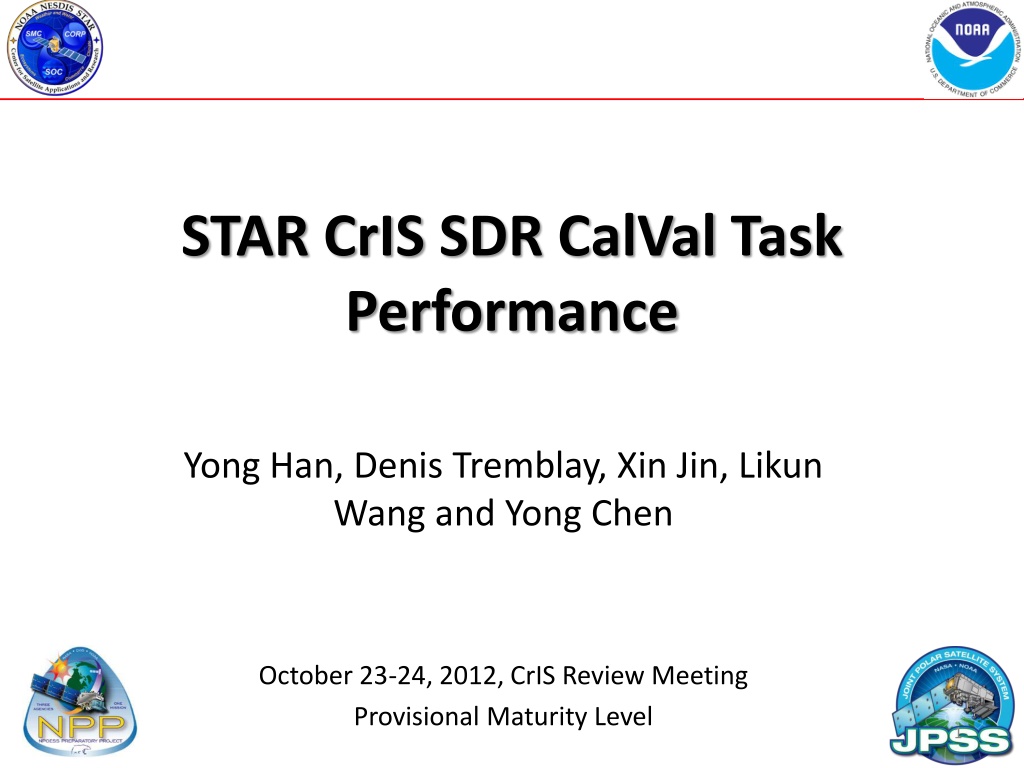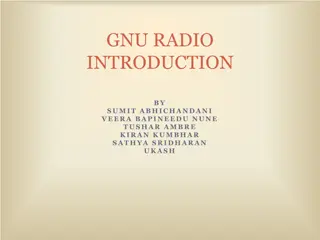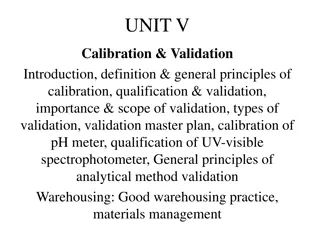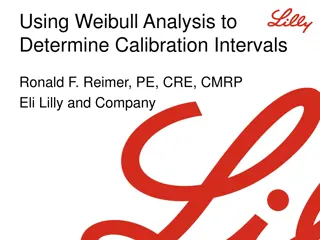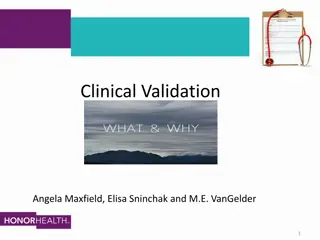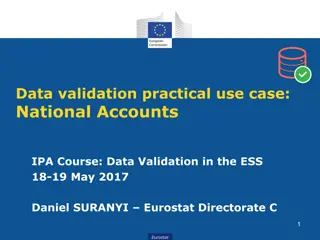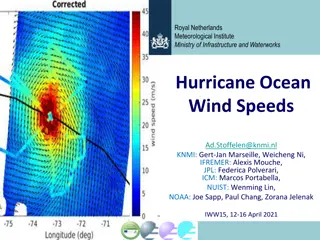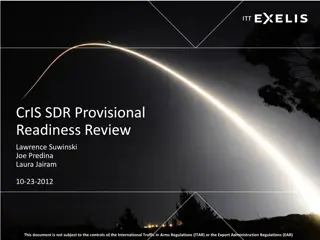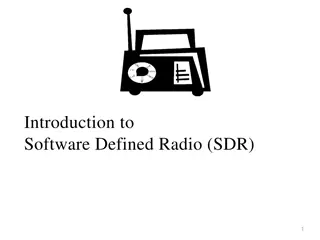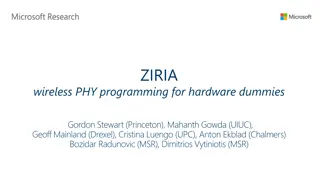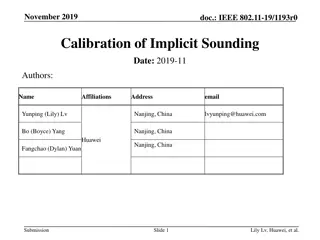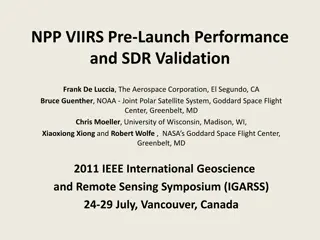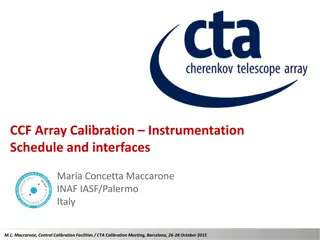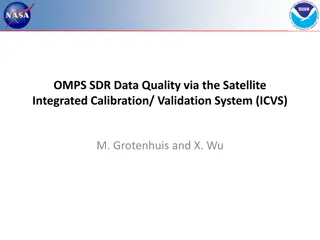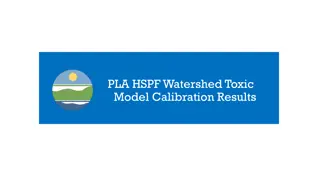Performance Review of STAR's CrIS SDR Calibration and Validation Task
This document provides an overview of the performance review conducted on the CrIS SDR Calibration and Validation Task at the STAR Review Meeting in October 2012. Tasks include managerial and technical leadership, trending and monitoring of instrument data quality, inter-sensor comparisons, measurement assessments, spectral uncertainty analysis, geolocation assessment, and algorithm/software improvements. Detailed comparisons between CrIS and other sensors like IASI, AIRS, VIIRS, and GOES are discussed, highlighting areas of agreement and improvement. The document also delves into specific tasks related to trending and monitoring systems, inter-sensor comparisons with various sensors, and overall performance evaluation.
Download Presentation

Please find below an Image/Link to download the presentation.
The content on the website is provided AS IS for your information and personal use only. It may not be sold, licensed, or shared on other websites without obtaining consent from the author. Download presentation by click this link. If you encounter any issues during the download, it is possible that the publisher has removed the file from their server.
E N D
Presentation Transcript
STAR CrIS SDR CalVal Task Performance Yong Han, Denis Tremblay, Xin Jin, Likun Wang and Yong Chen October 23-24, 2012, CrIS Review Meeting Provisional Maturity Level 1
Tasks Performed at STAR Task Name Description Status 1.Management Managerial and technical lead Continuous activity 2. Trending and Monitoring Monitor the instrument , RDR and SDR data quality Functional, continuous activity 3. Inter-sensor comparison CrIS with IASI, AIRS, and VIIRS; CrIS/IASI/AIRS with GOES Provisional status 4. Measurement assessment by CRTM Double Difference of CrIS vs. IASI; CrIS inter-FOV consistency Provisional status. 5. Spectral Uncertainty Cross correlation method On-going 6. Geolocation Assessment Using VIIRS as baseline. Bug fixed; Continue monitoring 7. Algorithm and software improvement DR investigation and bug fix. High resolution RDR Processing. On-going 2
Task 2 Web-based Trending and Monitoring System Spacecraft reset into Earth point safe mode on June 21; the measured laser wavelength slowly moved back to normal after June 25. Measured laser wavelength shows downward trend since 09/2012 ; the CMO will be re-calculate when wavelength drift exceeds the threshold. The upload of EngPkt v34 on June 27 fixed the pixel-level quality flag bug: the percentage of degraded pixels decrease to nearly zero. More than 60 parameters are automatically monitored: http://www.star.nesdis.noaa.gov/smcd/spb/xjin
Task 3: Inter-Sensor Comparison CrIS vs. IASI at SNOs IASI CrIS Total of 852 SNO Pairs 411 North Pole 441 South Pole CrIS - IASI CrIS and IASI have an agreement of 0.2K or better for all 3 bands. 4
Task 3: Inter-Sensor Comparison CrIS vs. AIRS at SNOs CrIS AIRS CrIS - AIRS CrIS and AIRS have an agreement of 0.3K or better over SNO locations at North Pole for 1253 pairs. 5
Task 3: Inter-Sensor Comparison CrIS vs. VIIRS NEdT large at low temperature CrIS-VIIRS CrIS-VIIRS Scene-temperature dependence can be seen at Band M15 CrIS-VIIRS CrIS is warmer than VIIRS at M15 and M16 but is colder at M13 CrIS-VIIRS BT difference for SNO cases are consistent with the whole orbital data. CrIS and VIIRS have a general agreement of 0.4K or better. 6
Task 3: Inter-Sensor Comparison CrIS vs. GOES AIRS/CrIS Under the GSICS framework, CrIS, AIRS, and IASI are routinely compared with GOES imager, which will help for GOES imager calibration. Courtesy of Fangfang Yu, STAR/GSICS Inter-calibration results among CrIS-GOES, AIRS-GOES, and IASI-GOES agree well.
Task 4: Measurement Assessment by CRTM CrIS and IASI double difference = Obs ( ) Obs ( ) DD CRTM CRTM 2 CrIS IASI CrIS Over 400,000 data points Double Difference Clear Sky over Ocean Double difference of CrIS and IASI relative to CRTM calculated radiance are within 0.2 K for most of channels. 8
Task 4: Measurement Assessment by CRTM Inter-FOV difference = Obs ( ) Obs ( ) BIAS CRTM CRTM FOV FOV all i i CrIS Inter-FOV Consistency Over 100,000 data points FOV-2-FOV variability is small, within 0.2 K for all the channels 9
Task 5: Spectral Calibration Spectral Uncertainties characterized by CRTM Cross-correlation Method under Clear Sky between Observation and CRTM Simulation MWIR LWIR - FOV spectral calibration is consistent within 1ppm - Spectral calibration has 3ppm offset wrt CRTM for LWIR, and 4ppm offset for MWIR (both meet requirement) 10
Task 5: Spectral Calibration Doppler Effects in CrIS SDR data Spectral Shift Caused by Earth-rotation Doppler Effect = R c :channel frequency; : Earth angular velocity Rs: Distance of the satellite from the center of the Earth i : Inclination of the orbit; : Latitude : Scan angle FOR15 relative to FOR16 + sin( ) sin( ) sin( ) i i Doppler shift: s FOR1 frequency shift relative to FOR30 FOR1 relative to FOR30 The Earth-rotation Doppler effect can cause a channel frequency bias up to 1.3 ppm Very stable CrIS performance allowing detection of very small frequency shifts 11
Task 6: Geolocation Assessment Using VIIRS as a reference Original Collocation at (0, 0) Collocation after shift at minimum of cost function - 3.5 Km cross track and -2.7 Km along track are found in CrIS SDR data - Root cause was found to be a coding error. 12
Task 6: Geolocation Assessment Before and After correction Software bug was discovered in the operational code. Code fix was engineered by STAR and delivered to IDPS for implementation. Without correction With correction CrIS CrIS-VIIRS CrIS-VIIRS - Geolocation code has been fixed and implemented in MX6.3 (10/16/2012) - Geolocation accuracy is estimated to be 1.0 km within 30 scan angles. 13
Task 7: Algorithm/software Improvement Time Stamp Error in SDR codes Incorrect radiance of all bands, all FOVs and all scenes caused by the time stamp coding error with respect to the change of month. LW radiance before fix LW radiance after fix Code fix (in red) in /ADL/SDR/CrIS/src/SystemTimeUtilities.cpp UInt16 leftDays = CcsdsSecondaryHeader::numDaysSinceJanuary1_1958(&leftOperand); UInt16 rightDays = CcsdsSecondaryHeader::numDaysSinceJanuary1_1958(&rightOperand); UInt32 leftMils = (((((((leftDays * HOURS_PER_DAY) + UInt32 rightMils =(((((((rightDays * HOURS_PER_DAY) + -STAR fixed the code error and delivered it to IDPS. - It will be implemented in MX7.0 (April 2013).
Task 7: Algorithm/software Improvement: Processing Full Spectra - Truncation code to process high resolution RDR and produce low resolution SDR developed at STAR using ADL4.0. Two files were modified: ProSdrCris.cpp and ProSdrCris.h - One step processing (changes are done in memory) - Code given to IDPS for future implementation. Modify Processing Parameters Hi-Res RDR Read RDR Truncate IFGM Replace truncated IFGM into CCSDS Pkt Continue SDR processing at Low-Res Low-Res SDR CrIS AIRS
Task 7: Algorithm/software Improvement: New Quality Flag based on Imaginary Parts - New DQF based on the imaginary part of the spectrum is an excellent indicator of the quality of the real part. - This DQF is now implemented as part of MX 6.3 (October 16th 2012). September 25th 2012 (Ascending) The abnormal imaginary part radiance will be used as a basis for a new pixel-level quality flag, available on October 16th, 2012 16 With contributions from other team members
Task 7: Algorithm and Software/Improvement Overall Data Quality Flag Improvement The Beta product has 60% of the SDRs labeled Degraded CrIS Overall DQF fixed with threshold parameters tuning and code changes. Last change is related to the new Stage cooler 2 temperature drift limit (4.0K instead of 1.0K). This change will be part of EngPkt V35 tentatively effective on October 22nd. June 13th 2012 (Beta), EngPkt V33 October 13th 2012, MX6.2, EngPkt V34 With contributions from other team members 17
Discrepancy Report (DR) Status Closed DR Number Description Date Status 4821 Incorrect geolocation calculation 07/03/12 Closed 4794 Make the CMO-EngPkt available to end user 06/21/12 Closed 4680 CrIS Overall DQF set to degraded 04/13/12 Closed 4661 CrIS Overall DQF set to value 3 04/10/12 Closed 4557 CrIS IFGM Packets with Fill release to RDR/SDR 02/06/12 Closed 4478 CrIS Overall DQF set to invalid for cold Earth scenes 12/02/11 Closed -These DRs were identified as major and prioritized accordingly. - Since April 2012 (BETA), all high priority DRs have been closed allowing to achieve the Provisional status. 18
Discrepancy Report (DR) Status On-going or Open DR Number Description Date Status 4941 Action for CLASS to distribute the CMO-EngPkt file 10/03/12 On-going 4909 Scan anomaly (time stamp issue) 09/21/12 On-going 4812 Add a flag indicating the CMO values have changed 06/28/12 On-going 4774 Corrupted CMO matrix leading with radiance with zero values (May 30th June 7th radiance anomaly 06/11/12 Approved for future evaluation 4508 Earth spectra quality flag set to degraded when FCE detected 12/22/11 Approved for future evaluation 4481 FCE correction algorithm does not work for cold Earth scenes. (substantial level of effort). 12/06/11 On-going 4407 Inconsistency with serialization (related to CMO archiving) 10/19/11 open 19
Discrepancy Report (DR) Status On-going or Open DR Number Description Date Status 4391 Some Interferogram.cpp operators need to be updated 10/13/11 Open 4389 Earth scene ZPD magnitude data type field inconsistencies 10/13/11 Open -The remaining open DRs are minor. - DPE/DPA and NOAA-STAR agree that these remaining DRs are not needed for provisional status. 20
Issues and Challenges SW cold scene FOV-to-FOV difference. Spectral (un-apodized) ringing. Operational ground data system instability causing one week of bad radiance product (May 30th to June 7th). Problem was not replicated and root cause is unknown. FCE detection/correction module was turned off Although, currently missing the component in the Ops code does not pose a significant problem as the FCE is a rare event up to now, but there is no guarantee that it will not be a problem in the future. Software bug fixes and possibly some algorithm redesign are needed, which require a large team effort. Inefficient and ineffective code changing process, causing delays and uncertainties of algorithm and software fixes and updates. Augment the code with diagnostic products that allows extraction of key internal values such as raw spectra, temperatures, and many others. 21
FY-13 Schedule and Milestones STAR s responsibility for changing EngPkt parameters and its upload, v35 Oct. 20, 2012 CrIS SDR user guide, December 2012 Tools for trending and monitoring radiance differences between CrIS and IASI/AIRS/VIIRS, March 2013 Geolocation uncertainty trending and monitoring tool, March 2013 STAR CrIS SDR processor (IDL code): CrIS Interferometry Transformation System (CITS), March 2013 Spectral uncertainty trending and monitoring tool, June 2013 RDR generator, September 2013 22
Summary of SDR Uncertainty Method Result Requirement Radiometric Assessment -SNO CrIS vs AIRS/IASI -Double difference -GEO SNO match 0.4K or better DD match 0.2K or better 0.3K or better 0.45% LW 0.58% MW 0.77% SW at 287K BB. Radiometric Assessment -Double Difference 0.2K or better Same as above Radiometric Assessment -GEO vs LEO 0.3K or better Same as above Spectral Calibration Using CRTM 3 ppm LW 4-5 ppm MW < 10 ppm Geolocation Accuracy CrIS vs VIIRS 1.0Km accuracy at nadir 1.5 Km 23
Summary CrIS and IASI have excellent radiometric agreement. CrIS data and CRTM have a 3ppm spectral calibration offset in LW. NOAA-STAR fixed the geolocation calculations. The high priority DRs have been addressed, now focusing on lower priority DRs. NOAA-STAR assessment is that the CrIS SDR product is ready to be declared provisional. 24
